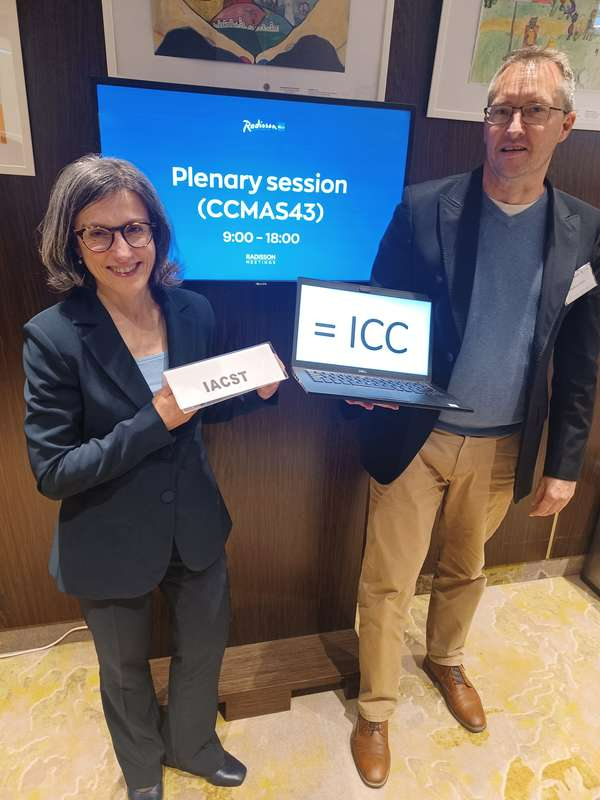Our member R-Biopharm is looking for a German and French speaking Account Mangager. Please find more information here: Account Manager/in (m/w/d) für die Lebensmittel- & Futtermittelanalytik – Vertriebsgebiet Schweiz (umantis.com)
ICC is happy to welcome Dr. Lokesh Kumar as new National Delegate from Country Member New Zealand!
Dr. Lokesh Kumar is a Lecturer in the Department of Wine, Food, & Molecular Biosciences at Lincoln University, New Zealand. Dr. Kumar specializes in food materials and structure, focusing on interactions between dairy and plant proteins with other biopolymers. His research interests encompass food rheology, texture, hydrocolloids, and microstructural characteristics of food components. Dr. Kumar's expertise includes food macromolecule interactions, functionalities of food hydrocolloids, cereal/dairy ingredients manufacturing, food structure and texture design, food rheology and tribology, and food digestion. His work aims to develop novel protein/carbohydrate polymer systems for applications in soft food gels, texture modifiers, and stabilizers.
Dr. Kumars research has been published in numerous prestigious journals, reflecting his commitment to advancing food science and his dedication to education in this field.
We look forward to a fruitful collaboration!
Cereals and grains form the basis of global diets and the staples made from these crops are a key to end hunger and malnutrition (SDG 2 and 3). Furthermore, cereal and grains are important for living income for farmers and many more along their value chains. However, local production declines and the impact of climate change on cereal production and of geopolitical shocks like the wheat crisis show the lack of resilience of the current food systems in e.g. sub Saharan Africa.
ICCs Cereal Science community is currently mostly focused on Western and upcoming markets and on the main commodities wheat, maize and rice. With this initiative we aim to raise awareness among ICC’s cereal scientists about the growing global scourge of food and nutrition insecurity and to strengthen ICC’s activities and impact on the challenges of the global South.
Excellence of ICC cereal scientific network
- Build an ICC network accessible for (young) cereal scientists in resource poor countries. How can we better involve - and be more accessible for - (young) African/low-income country scientists?
- Promote ICC as the authoritative and independent knowledge and expertise platform on cereals and grains among scientists in the global South.
- Get an overview of ICC people, their collaborators in resource poor regions and their projects related to Cereals and Grain Science for Global Food and Nutrition Security
Relevance of ICC cereal science knowledge
- Raise awareness among cereal scientists about the growing global scourge of food and nutrition insecurity.
- Create a scientific debate about (nutritional) interventions and dietary shifts concerning cereals and wholegrains.
- Develop concerted action type project proposals to empower cereal scientists by sharing scientific approaches and methods like Food System Thinking and successful nutritional interventions
Do you want to join actively in this ICC initiative or share ideas? Send e-mail to
find more information in these presenations: https://icc.or.at/icbc24
Two delegates from the International Association for Cereal Science and Technology (ICC), Dr. Valentina Narducci, the ICC Technical Director, and Dr. Markus Lacorn, a member of the ICC Technical Committee and a Corporate Member (R-Biopharm), attended the 43rd meeting of the Codex Committee on Methods of Analysis and Sampling (CCMAS 43) in Budapest from May 13-18, 2024. The meeting was preceded by an Inter-Agency Meeting (IAM) on May 12, which brought together standards development organizations (SDOs) associated with CCMAS.
Key Outcomes and Discussions
- ICC Methods Included in Codex List: The meeting saw the inclusion of ICC methods in the Codex list of recommended methods of analysis and sampling (CXS234). This is a significant milestone in the ICC's efforts to promote international standards in cereal science and technology.
- Guideline for Particle Size Distribution: The ICC Recommendation 207 was endorsed as a guideline for measuring particle size distribution of edible cassava flour and gari. However, it was noted that the recommendation will need to be revised this year to include the possibility of using sieves with mesh sizes relevant for these commodities.
- Incineration Temperature Discussion: The meeting discussed the incineration temperature for various commodities. While several arguments were considered, the question remains open. The Codex Commission will be asked for guidance on whether CCMAS can receive assistance in determining the original intent for ashing temperatures in cereals, pulses, and legumes standards. If not, two provisions for ash at 550 °C and 900 °C for some commodities could be acceptable to allow CCMAS to endorse recommended methods.
- Methods of Analysis for Precautionary Allergen Labelling: The CCMAS was asked by the Codex Commission to prepare a discussion paper on methods of analysis for precautionary allergen labelling to support the work of the Codex Committee on Food Labelling (CCFL). The ICC contributed to the discussion by commenting on the first draft document, and the discussion will continue until consensus on a final document is reached.
- Strengthening Collaboration: The meeting provided an opportunity for friendly discussions with representatives of other SDOs, and the ICC was invited to strengthen its collaboration on issues of common interest.
Overall, the meeting was fruitful, with the ICC contributing to discussions and strengthening its relationships with other SDOs.
Within the ICBC24, we celebrated Awards of the Best Posters sponsored by Journal of Cereal Science, the Official Journal of ICC and the best young speakers sponsored by Foods and Oniris. Celeste Verbeke and Enni Mannila received the Best Poster Award, while Silvia Cera, Shpresa Musa, Muhammad Yahya, and Alejandra Paola Velásquez Barillas were recognized as the Best Speaker Awardees.
We extend our warmest congratulations to all awardees and wish them continued success in their contributions to cereal science. Thank you for showing your outstanding work at the ICBC24!




